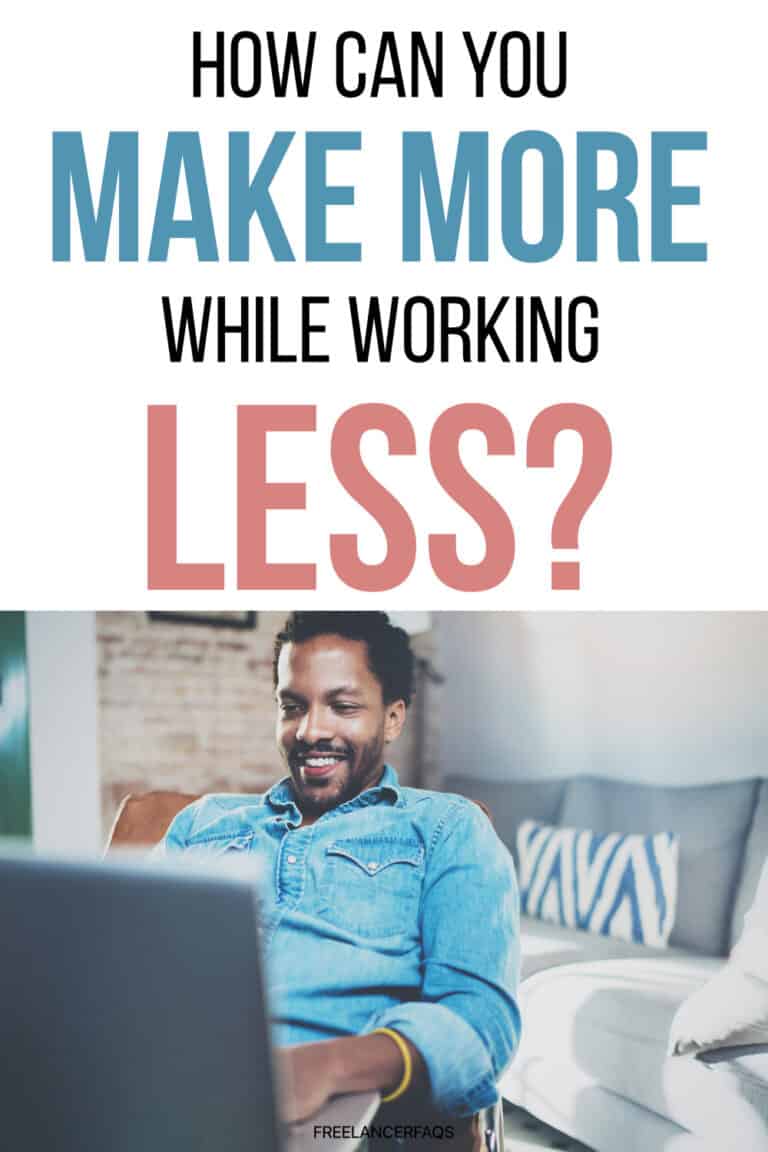If you’re a freelancer, especially if it’s been awhile, you’ve probably asked yourself the question, “how can I work less and make more” at least a million times.
I know when I started freelancing almost 7 years ago, both of those things were often on my mind.

[Y]ou’ve probably asked yourself the question, “how can I work less and make more” at least a million times.
I knew that I made the right decision for myself to start freelancing, but I definitely wasn’t prepared for some of the challenges that it brought.
Granted, for all of the wide eyed and busy tailed folks who do want to get started soon, there is the honeymoon period where everything is fresh and new and ANY amount of money you make seems amazing.
I have fond memories of those days but that usually doesn’t last forever.
If you’re someone who’s been freelancing for years and you’re completely content with the amount of work that you do and your income, you’re my hero.
You’ve seriously won the game of life and should write a book.
But for the rest of us, at some point when the difficult projects come rolling in, the stress of constant new client acquisition weights on you, and you begin to hit your absolute limit of billable hours, you get a little grumpy.
A little fed up.
Do any of these sound like you?
Common Freelancer Problems to Watch Out For

Maybe you’ve not yet had the thought pop into your head that you’d like to make more money while working less.
You might not even think that your current situation isn’t so bad.
That being said, even if you don’t want to earn more and work less just yet, there are many ways you might be shooting yourself in the foot with your freelance business.
Here are some common roadblocks I see with new or growing freelancers that hold them back from more fulfilling work and lives.
Trading Time for Money
When you’re a brand new freelancer, there’s nothing wrong with taking on mostly project based or hourly work. In fact, it’s completely normal and expected.
However, if your entire income is always tied to billable hours, then you’re essentially building a trap for yourself.
Not only will you eventually want to take time off, which will result in you not getting paid for those hours you missed, but you’ll also inevitably hit a limit on your time.
There’s only so many hours in the day.
Freelancing and being your own boss is supposed to bring a level of flexibility and freedom into your life.
Punching in hours day after day in order to get paid isn’t the reason you took the chance on yourself and ditched the 9-5.
Low Pricing
Sometimes new business owners have a difficult time asking for money and getting paid what they’re worth.
If you didn’t have a job where you regularly asked for large sums of money like investment banking or a sales role, it can be daunting and even scary to look your client in the eye (or their virtual eyes over Zoom) and ask for a reasonable fee.
Even though that thinking is normal, not asking for proper compensation is going to slowly eat away at your livelihood.
You also will need to earn more than you think to cover expenses, potential health insurance related bills, taxes, and other aspects of day to day life that you didn’t think twice about when you had a normal job.
In order to understand how you should price yourself when first starting out, take a look at this insanely helpful freelance rate calculator that will help you objectively work out how much you should be charging for your work to live the kind of life you want to live.
If you’ve had the thought even once that you aren’t charging what you’re worth, you’re probably right.
Custom Work
Just like a mismatch in your pricing strategy, when you’re new to freelancing, being a jack of all trades can be a good strategy.
If you’re really low on income, have a very broad and shallow skillset, or aren’t sure what kind of work you want to specialize in, then taking on different kinds of projects to get a feel for your sweet spot while making ends meet is completely reasonable.
The issue is when this lack of specialization goes on for too long.
In the world of freelancing, experts who have deep expertise across one or two primary domains are usually the ones who command the highest prices and who set the tone for their engagements.
Their clients view them as trusted advisors and work within their systems because they trust their experience.
So those freelancers and consultants end up having the best gigs on top of being the highest earners.
The reason they can do this is because their work is well defined from all of those years of experience and they have developed confidence from giving their clients exactly what they promise each and every time.
Without specialization, you’ll be able to provide your services, but only to an average level.
You’ll never reach true mastery and without mastery, it’s hard to differentiate yourself in today’s freelance marketplace.
Grumpy Bad Fit Clients
You know the ones…
Nothing is ever good enough for them.
They want to negotiate and haggle your prices down, so you end up working on the cheap.
Beyond that, there’s an endless amount of revisions, back and forth unnecessary communication, and expected work to be done for free.
These folks are the absolute worst, but they exist, and it’s easy to fall into a trap where you feel like these are the only clients you can get.
The truth of the matter is that you’re only working with these folks due to a poorly defined ideal client profile.
As a new freelance business owner, it’s ultimately up to you to DECIDE exactly who you’re going to help and how you’re going to help them.
Even though it’s hard, you’ve got to learn to say no to anyone that’s not a good fit for what you offer or someone who you know will be a pain for you to work with.
Too many bad fit clients can completely derail your progress and lead to burnout.
How to Work Less Hours and Make More Money

Okay, so now that you’ve seen the light and we’re on the same page with those potential roadblocks, you can rest easy knowing that there’s a better way.
This isn’t clickbait.
There really are concrete strategies and tactics to improve your quality of work, while working less hours, and generating more income as a freelancer.
The key is knowing which steps to take, being disciplined about implementing them, and then sticking to the plan long enough to reap the rewards.
Are you ready?
Great.
Let’s dive in.
1. Create a Single Awesome Offer for One Awesome Person or Company
 The first and most important step when it comes to making more and working less as a freelancer is to reduce and refine.
The first and most important step when it comes to making more and working less as a freelancer is to reduce and refine.
If you’re like most freelancers, you probably have a bunch of different offers and deliverables for clients, that depend mostly on what they ask you to do.
There’s zero or few repeatable aspects about your work and since it changes so constantly, it makes it really hard for you to hone your skills and charge more.
The key here is to settle in on one offer or combine a few different offers into one streamlined package for your number one most profitable and enjoyable client.
A great exercise to help you do this is to create a Google sheet with the following columns based on everything you’ve ever created or delivered for money as a freelancer:
- Name of offer
- Description
- Final deliverables
- Price you charged
- Who you did it for
- Hours needed
- Resources needed
- Scale of 1-10 of how much you enjoyed the project
From here, you’ll have a high level view of what you’ve done in the past, who you did it for, what it took to deliver well, and how well the project turned out.
At this point, you should see patterns emerge of which service requires the least amount of time, but that you can reliably and enjoyably execute.
Or if nothing else, it will be glaringly obvious that the work you’re doing isn’t the work you should be doing.
Next, you’ll take these insights, and use them to spend time and craft your new offer to your ideal clients.
Instead of “freelance graphic designer” who charges $40/hour for graphic design work, you now “help aging local mom and pop shops reinvigorate their image through 1 week brand transformation workshops”.
See the difference?
If your proposals are getting rejected, it’s likely because your value proposition doesn’t meet the needs of your target audience.
After this exercise, you can craft the perfect proposal and win bigger deals because you will have a much clearer idea of the value you’re bringing and who it serves.
2. Increase Your Prices and Sell Based on Value
Once you’ve solidified your offer into a repeatable and predictable deliverable you get to level up in another way.
Increase your pricing.
I know…I know…I can hear some of you saying “but Ken, you don’t know my situation, i’m not that good” or “if I charge more how will I ever get any clients, all clients want is the cheapest option.”
Look, I get it, and I had those same exact thoughts at one point in time as well.
If you’re truly not very good at what you’re doing yet, then you obviously can’t charge top of the market prices or you won’t be delivering any value for your client.
That being said, for those of you who have been at this for a while, or who started freelancing with real experience and the ability to deliver on your promises, I double dog dare you to raise your prices.
I guarantee you that what you think will happen won’t happen.
It certainly didn’t for me.
In fact, every time I’ve raised my prices it’s forced me to sit down, reevaluate my offer and improve it to the point where I can feel good about my client getting a return on their investment with me.
For you it may not be about the monetary ROI but they’ve still got to get a deliverable or offer worth as much or more than what they are paying you.
As long as you cover that, you’ll be golden.
On top of that, you’ve got to shift from a mindset of “I’m going to work this many hours so I’m going to get paid this much” to an attitude of “I’m delivering X amount of value for my ideal client which is worth Y to them so that’s what I’ll charge” when you’re pitching your services.
This is a key way to earn more while reducing your ratio of hours worked because you’re creating a more valuable offer without it being attached to the number of hours you spend on a project.
To help illustrate this point, here are two examples:
- A marketing agency that spends 40 billable hours (at $50/hr) cold calling potential new customers for a new software company. The campaign leads to 0 new leads or sales. Their total cost was $2000 for the month.
- Another marketing agency spends 3 total hours setting up a Google Ads campaign that runs on autopilot and ends up generating 5 sales for the software company. They charge $11,000 for the month.
Which of those companies is more valuable and likely to get repeat business?
That’s right, company number two.
Even though $11,000 might seem like a lot to some of you, those 5 clients might be worth $90,000 to the business when it’s all said and done, which gives them a good return on their spend.
The first company spent a bunch of time and effort doing stuff, with no tangible return.
If you’re a creative, not a marketer, consider this example:
- A self described “creative freelance blog writer” charges 3 cents per word to write about any topic. A hired gun. For one 1500 posts, they charge $45.
- Another blogger, but they describe themselves as “a content marketing lynchpin who helps b2b SaaS companies attract more demand through laser focused technical writing.” They also write 1500 word blog posts, but also do the necessary competitive gap analysis, keyword research, and post publish SEO optimizations. That only adds 2 hours to their total writing time, but they charge $450 for the same post.
You can already guess which is more valuable to the client.
That’s the power of combining a killer offer that you know adds massive value for your client with increased pricing that meets the strength of your offer, and selling the end result for your client, versus your time.
3. Create SOPs and Repeatable Processes for Yourself
Another key aspect of earning more money while working the same or less is the process of standardizing your operations. The most important step here is by creating SOPs.
SOP stands for standard operating procedure.
This is a document, template, video, and/or checklist that describes in detail how you accomplish each client deliverable or internal process.
Some freelancers assume that because they’ve always done something one way, that they are doing it the same way every time.
Even if that’s the case, writing it down will really force you to think about what you’re doing and if there’s a better way to do it or not.
Also, picture having 11 freelance clients at once, you’re tired, and you’ve still got a long day ahead of you. Is it possible that you might make a mistake even doing something you’ve done a million times before?
You betcha.
Working from a checklist, or at least double checking your work against the SOP will save you time and embarrassment from revisions after you send the sub par work to your client.
You ideally should create SOPs for every single aspect of your deliverable, down to your sales pitch, project management systems, invoicing, and the process used to create the deliverable as well.
Here are two great resources to build out your own SOPs:
Over time, as you get better and better at delivering your perfect offer, you will be able to continue to increase prices because you can guarantee certain outcomes for clients after having the historical data to back it up.
4. Find a Partner Who Offers Complimentary Services and Take a Cut
Some freelancers are against the idea of partnering with other freelancers or subcontracting work.
In all honesty, I waited over a year of freelancing before I would even consider it.
It’s a decision I regret.
The truth is that your clients likely don’t view you having a VA or a partner freelancer the same way you do. Some clients do want a single freelancer and only one on a particular project.
These are the minority.
In general, clients want a SOLUTION to a problem, not just a bunch of paid hours for tasks. So they likely don’t care who’s doing what, as long as it gets done and the perceived value is worth it to them.
So make it a priority to find either:
- A freelancer who offers different but complementary work to yours (think a web developer freelancer to an SEO freelancer)
- A virtual assistant who can take on more repetitive, monotonous, or less knowledge intensive tasks for you so that you can dedicate more of your time to more important and high impact tasks for your client.
You charge more, the client gets more of your A game, and you can take on more work without adding double the hours of your time.
It’s a win win win.
Big Takeaway
As a freelancer, you’re going to go through a lot of highs and lows.
In the beginning it might seem like you’re working way too long for way too little pay.
To some extent that’s normal.
However you’ve always got to keep in mind the reasons why you took the leap into freelancing in the first place. To improve your income, gain freedom, and improve your life.
In order to earn more without tripling your work week, you’ve got to get crystal clear on your offer, increase your pricing based on your provided value, standardize your delivery, and don’t be afraid to partner or outsource certain tasks.
Happy Freelancing!



Leave a Reply